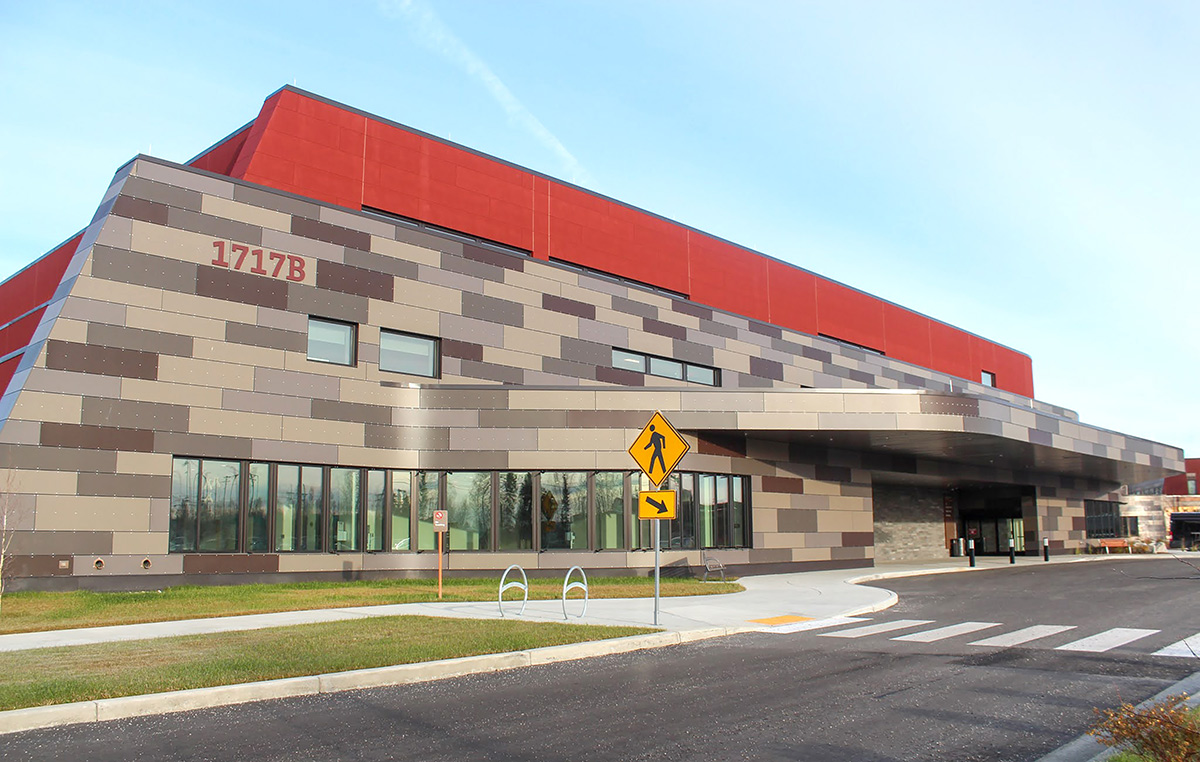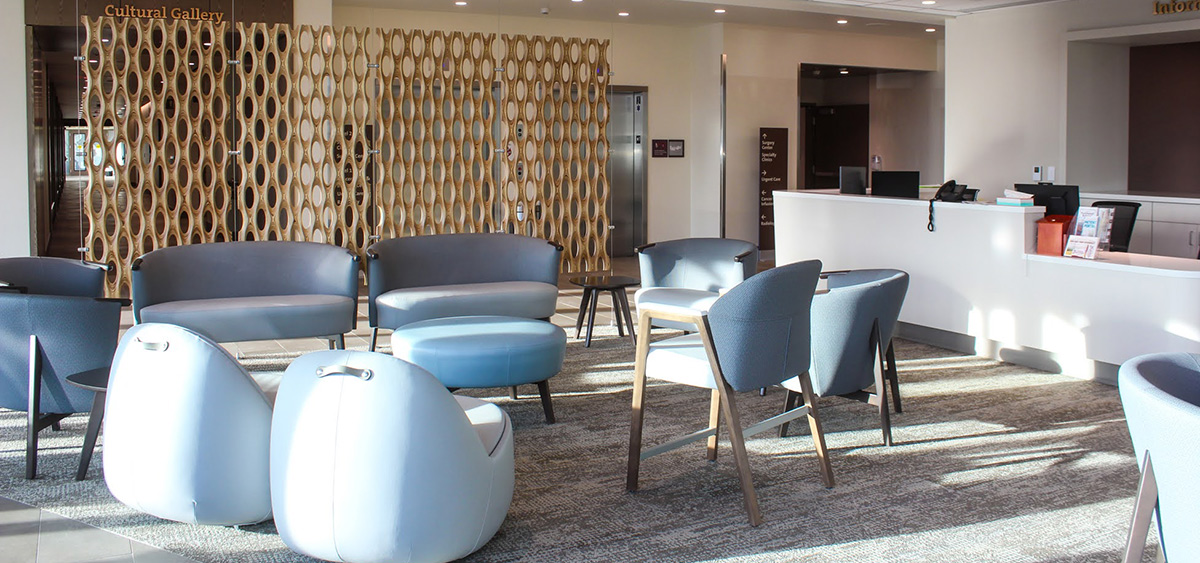
Update
Care
Near
Home
Photo provided by Davis Constructors & Engineers
Photo provided by Davis Constructors & Engineers
laska’s 663,300 square miles are a large part of its appeal—and part of the challenge of living here. For many, Alaska’s vast landscapes make it difficult to access healthcare, particularly in the state’s rural areas. But a pair of medical centers are working to minimize those challenges by expanding both their facilities and the services they offer to improve patient access to medical care closer to home.
“The new hospital will be modernized to allow for technological advancements, as well as individual patient rooms to accommodate our patients’ needs,” she says. “It will also allow for improved efficiencies between departments for providers and patients, including placing the imaging department next to the emergency department and surgery next to the obstetrics department.”
Associated General Contractors, or AGC, of Alaska member companies ASRC SKW Eskimos and Davis Constructors & Engineers, Inc., working as joint venture ASKW-Davis, LLC, broke ground on the project in summer 2022. Project Manager James Murrell says the project is slightly ahead of schedule.
“We topped out the steel and installed all of the air handling units for Tower A [at the end of October], and half of the building is poured out with concrete, so all of the structure is essentially erected,” he says. “We should have the concrete poured out for both buildings most likely by the middle of January, and the exterior nerve and curtain wall going around the same time. Then we can move to the interior.”
Davis Constructors is pouring all the project’s concrete on-site, something Murrell says the company has never done before.
“There are 8,000 cubic yards of concrete on-site,” he says. “We wanted to be able to pour a significant amount of concrete in a single day, and that wasn’t going to be feasible with the available resources. There was a little bit of a learning curve in the beginning, but it’s been going very well.”

Photo provided by Davis Constructors & Engineers
“We had grown out of the building,” says TCC’s Executive Director of Quality and Development Jennifer Eden. “I think health services had grown 400 percent since we built Building A. We had turned every supply closet, utility closet—whatever we could find—into office space.”
The dramatic growth prompted TCC, which serves a 235,000-square-mile area, to begin expansion plans earlier than anticipated. The result was Building B, a three-story, 108,000-square-foot facility completed in July 2022. The third floor includes 15,000-square-feet of shell space to accommodate future expansion.
Connected to the original clinic by a 100-foot enclosed corridor, Building B offers an array of new and expanded services, selected in part from patient input, including an ambulatory surgery center, expanded urgent care clinic, diagnostic imaging, and a cancer care infusion center.
AGC member company and general contractor GHEMM Company, LLC joined the project at concept in January 2020 and worked closely with project designers and the TCC committee, providing constructability review and advice on best practices, says GHEMM President Meg Nordale. That included helping to scale down their initial plans for the facility.

- PND Engineers, Inc.
- AMC Engineers
- Alcan Electrical & Engineering
- Alaska Professional Construction, Inc.
- General Mechanical, Inc.
- K&E Alaska, Inc.
- Otis Elevator Company
- Rain Proof Roofing
- CRW Engineering Group, LLC
- Arcadis US, Inc.
- DOWL
- AMC Engineers
- Estimations, Inc.
- American Health & Safety, LLC
- Mappa, Inc.
- Exclusive Paving
- PFK Enterprises
- Precision Cranes, Inc.
- Denali Fenceworks, LLC
- J.D. Steel Company, Inc.
- Allied Steel Construction, Inc.
- Carlile Transportation Systems
- Andy Milner Co.
- A&A Roofing Co., Inc.
- Commercial Contractors, Inc.
- Vertex Insultation, Inc.
- Gundersen Painting, Inc.
- Frontier Supply Company
- Spenard Builders Supply
- Otis Elevator Co.
- Patrick Mechanical, LLC

Photo provided by GHEMM Company, LLC

Photo provided by GHEMM Company, LLC
Eden and Nordale agree that GHEMM’s early inclusion, combined with a prior working relationship (GHEMM was the general contractor for Building A), was the foundation that helped the project run smoothly.
“I think the whole process worked really well, to have the contractor, the architect, and the healthcare planning committee work very closely together,” Eden says. “It helped to have all these groups together as opposed to designing something and then everybody gives their opinions.”
GHEMM “was in the ground” in July 2020, Nordale says. Despite starting work during the height of COVID-19 restrictions, she says that aside from supply-chain issues that affected every other industry, the pandemic didn’t create any significant delays. Construction of healthcare facilities was deemed an essential service, GHEMM had no workforce issues, and there were fewer challenges related to on-site traffic and patient/staff safety concerns.
“We were actually constructing it at a good time,” Nordale says. “We never really shut down.”
TCC assembled a cultural committee to ensure that the facility’s design would reflect the region, community, and Alaska Native culture. Their suggestions helped “soften” the utilitarian, antiseptic feel of most healthcare facilities, Nordale says, and made the project stand out from other hospital projects GHEMM had worked on.
“There are places set aside for artwork. The lights are softer, the finishes are softer, there are more earth tones and natural things,” she says. “There are meditation rooms that have spruce-lined walls, and there’s a lot of round corners and space to gather. There’s this calmness that comes over all of it.”
Eden says patients have already expressed appreciation for the atypical design and attention to cultural components.
“The population that we serve is very grounded in their culture,” she says. “When the executive board and the cultural committee came through for a tour, I remember one woman saying that having her culture all around her when she’s sick helps her to heal better as opposed to being in a sterile white box. Our patients love it.”